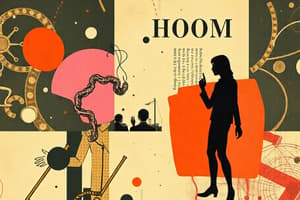Podcast
Questions and Answers
What is the primary use of stem cells mentioned in the text?
What is the primary use of stem cells mentioned in the text?
- Immune system enhancement
- Tissue regeneration (correct)
- Stem cell therapy
- Organ transplantation
How are stem cells stimulated to differentiate in the lab?
How are stem cells stimulated to differentiate in the lab?
- By exposing them to ultraviolet light
- By altering the pH level of the culture medium
- By increasing the temperature of the culture dish
- By changing the chemical composition of the culture medium (correct)
What is the process called when culture dishes become crowded as cells divide and need to be re-plated?
What is the process called when culture dishes become crowded as cells divide and need to be re-plated?
- Superculturing
- Hyperplating
- Overculturing
- Subculture (correct)
How are batches of stem cells transported to other labs for further culture and experimentation?
How are batches of stem cells transported to other labs for further culture and experimentation?
What method is used for stem cell therapy, which may require immunosuppression?
What method is used for stem cell therapy, which may require immunosuppression?
What is the process called when culture dishes become crowded as cells divide and need to be re-plated?
What is the process called when culture dishes become crowded as cells divide and need to be re-plated?
How are stem cells stimulated to differentiate in the lab?
How are stem cells stimulated to differentiate in the lab?
What is the primary use of stem cells mentioned in the text?
What is the primary use of stem cells mentioned in the text?
What is the most important source of stem cells for tissue regeneration and therapy?
What is the most important source of stem cells for tissue regeneration and therapy?
1
1
Flashcards are hidden until you start studying
Study Notes
Primary Uses of Stem Cells
- Mainly used for regenerative medicine and tissue repair.
- Critical for understanding development and disease pathology.
Differentiation Stimulation
- Stem cells are stimulated to differentiate through specific growth factors or signaling molecules.
- Conditions such as temperature, oxygen levels, and substrate can also influence differentiation.
Cell Re-plating Process
- When culture dishes become crowded due to cell division, the process is referred to as "passaging" or "subculturing."
- Re-plating is essential to maintain healthy cell growth and prevent over-confluence.
Transport of Stem Cells
- Batches of stem cells are typically transported in controlled temperature conditions to ensure viability.
- Specialized packaging materials are used to protect cells during transit, avoiding physical damage.
Stem Cell Therapy Method
- Stem cell therapy often employs autologous stem cells, meaning they are derived from the patient’s own tissue.
- Immunosuppression may be required to prevent rejection of transplanted cells.
Most Important Source for Tissue Regeneration
- Induced pluripotent stem cells (iPSCs) have emerged as a significant source due to their ability to differentiate into any cell type.
- Adult stem cells, such as those from bone marrow and adipose tissue, are also critical for therapies.
Studying That Suits You
Use AI to generate personalized quizzes and flashcards to suit your learning preferences.




